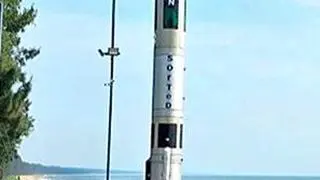Vivek Wadhwa, an entrepreneur from Silicon Valley, wants to create a portable device that will help detect cancer from breath.
“We’re opening up another dimension. Let’s see where it takes us,” says Wadhwa, whose company, Vionix Biosciences, has been working on the project.
Wadhwa has been searching for ways to reduce the cost of medical testing, particularly for diagnosing different types of cancer beyond the visible ones like throat and breast cancer. While the work outcome is filled with uncertainty, he is optimistic that they can get this technology working in the next year or two.
Read: Cancer killing nanoparticles
The device will function by converting organic compounds into light spectra, similar to how we analyse DNA sequences by deciphering the letters. “We’re looking for specific signatures within these light spectra to detect diseases and cancers,” says Wadhwa.
Lessons from the Holmes saga
The last company that was working closely on something similar to this was Theranos, founded by Elizabeth Holmes, an entrepreneur who started her long prison sentence this May following long legal battles. Theranos was a high-profile health tech company led by Holmes, aiming to revolutionise blood testing with minimal blood samples. However, it faced controversy and legal challenges due to concerns about the accuracy and credibility of the company’s methods.
Read: IIIT-Hyderabad develops smartphone-based oral cancer screening tool
“This whole field has a very bad reputation because of Theranos, and that’s why we will have externals look at our product,” says Wadhwa. “We’re going to start giving it to university researchers and let them start doing advanced research on this too,” adds Wadhwa.
Cancer testing from breath
The use of breath to detect lung cancer isn’t something new. In a research paper titled, “Lung cancer detection via breath by electronic nose enhanced with a sparse group feature selection approach,” published in 2021, scientists made a special “electronic nose” to detect lung cancer by studying people’s breath. They tested it on 87 people: 46 with lung cancer, 36 healthy and 5 with other lung problems. The machine had 13 different sensors to analyse the breath. It turned out the machine could tell lung cancer from other problems really well.
However, Wadhwa says that his research will not only help identify any form of cancer but also diseases like tuberculosis and “other diseases that can be detected through breath.”
Wadhwa, who met Prime Minister Narendra Modi this year, says that he got full support from the Prime Minister for his idea to eradicate cancer. So far, Wadhwa has invested more than $40,00,000 in the project. He intends to invest $50,00,000 more.
Analysing complex data from breath, blood, and urine using mass spectrometry is challenging for humans. AI, designed for data analysis, is ideal for this task, as it requires training to understand data and create models, says Wadhwa. However, AI needs extensive data and samples to learn about various diseases, given the complexity of the light spectrum data.
A long way to go
If this experiment is successful, this will be a new chapter in medical history. However, there are lots of challenges, and it’s too early to comment on the success of the experiment. The biggest risk is that the technology won’t work or that the data will be too complex to understand. A research paper named “Detection of cancer through exhaled breath: a systematic review” published in 2015 points out, “...analyses of exhaled breath yielded promising results, although standardisation of breath collection, sample storage, and data handling remain critical issues.”
Thus, larger studies should be implemented in true screening settings, paying particular attention to standardisation in breath collection, consideration of co-variates and validation in independent population samples.








Comments
Comments have to be in English, and in full sentences. They cannot be abusive or personal. Please abide by our community guidelines for posting your comments.
We have migrated to a new commenting platform. If you are already a registered user of TheHindu Businessline and logged in, you may continue to engage with our articles. If you do not have an account please register and login to post comments. Users can access their older comments by logging into their accounts on Vuukle.